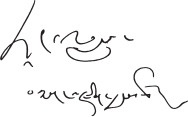

A maṇḍala is said to be extremely profound because meditation on it serves as an antidote, quickly eradicating the obstructions to liberation and the obstructions to omniscience as well as their latent predispositions. It is difficult for those of low intelligence to penetrate its significance.
There is a difference between entering a maṇḍala and receiving initiation. In order merely to enter a maṇḍala it is sufficient to have faith; it is not necessary to have generated the altruistic mind of enlightenment. Also, one may enter a maṇḍala and receive initiation without having fully generated the altruistic mind of enlightenment, but it is necessary for one who is training in the two stages of Highest Yoga Tantra to have done so.
In the past, entrance into a maṇḍala and granting initiation were used very carefully, discriminating between the two, but nowadays Tibetans tend to initiate anyone. Vajradhara set forth a complete system with different levels—those who could just enter a maṇḍala, those who could also receive the water and head-dress initiations, and so forth. When it is done systematically, the lama, prior to granting initiation, analyzes the student to determine whether he or she can engage in the three trainings [ethics, meditative stabilization, and wisdom] and keep the vows. The lama allows those who are not qualified but who have great faith to enter a maṇḍala but does not allow initiation. These systematic restrictions, which when followed make initiation effective and practical, are often not followed nowadays, causing trouble for both lama and initiate.
There is a story about Drugpa Kunleg who was visiting an area where a lama was bestowing initiation. When the lama passed by, all thereabouts rose and paid him respect, but Drugpa Kunleg did not. The lama playfully asked him what he was doing. “When I pass by, other people pay respect. Why are you displaying this ill behavior?” Drugpa Kunleg answered by asking, “Are you giving many initiations? Are you causing many to fall from their vows and pledges? Are you opening the way to hell for many?”
If you are able to think about the meaning of cyclic existence in general and human life in particular, then it is possible to discipline the mind through religious practice which is the process of becoming peaceful and anxiety-free. Otherwise, if too much emphasis is put on the sufferings of the hells and the imminence of death, there is a chance of falling into paralyzing fear. There is a story in Tibet about an abbot of a monastery who went to give a discourse. A fellow asked the abbot’s servant where the abbot had gone, and the servant said, “He has gone to frighten old folks.” If you fulfil the value of a human lifetime through engaging in religious practice, then there is no point in worrying about death.
Initially, you should take refuge in the Three Jewels from the round orb of your heart, then take a vow of individual emancipation, and after that generate the aspirational and practical minds of enlightenment. Then, when you arrive at the point where it is suitable to hear tantra, you should receive teachings on Ashvaghoṣha’s Twenty Stanzas on the Bodhisattva Vow (bodhisattvasaṃvaraviṃśaka) and Fifty Stanzas on the Guru (gurupañcāśikā). Then you may receive initiation.

The Buddhist monk, Tenzin Gyatso 2518 B.C.E., 1974 C.E., the Tibetan year of the Fire Tiger